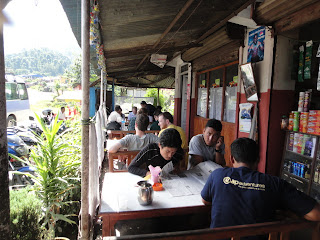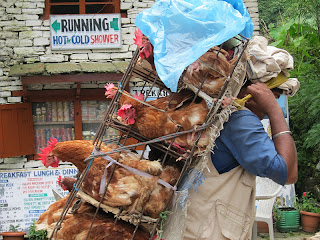We set off from Kathmandu on our tour bus and drive out of Kathmandu valley going west. The porters for our trek come with us. Amazingly this road is the only route in and out of the valley, so it takes all the traffic. We reach a check point on the brow of a hill and suddenly we have left the valley behind, with its brick factory chimneys and houses and we are instantly in a different landscape. Steep sided hills and valleys open up in front of us and the road in and out of the valley winds around the sides of the hills.
Coming towards us in the opposite direction is a constant stream of colourful lorries and buses crawling up the twisting road. The buses are so overcrowded that men sit on the roof with the luggage and the occasional goat.
Bus
Along the road-side are many open-fronted shops and tea shops. They cling on stilts at the back between the edge of the road and the almost sheer valley. People are living their lives and working right beside the dusty road. The landscape is so steep that this narrow band is the only place available. After a few hours we stop at a road-side restaurant and have a cup of Nepali tea. It is sweet and milky and flavoured with cardamom and cinnamon.
Tea stop
We often pass goats being herded out of the hills and along the roads and Anil tells us that today s the first day of the main Hindu festival of Dashain. This will go on for 15 days and part of the celebration includes sacrificing huge numbers of animals. These goats are going to meet a sticky end.
Goats
After 6 hours of driving we arrive at Pokara, where there is a beautiful lake. Beside this has sprung up a collection of hotels, shops and restaurants for the tourist trekkers. The whole place is full of people either preparing to go trekking or relaxing after coming back from the mountains. There are endless outdoor shops where you can buy or hire all your trekking gear – but no genuine labels in sight apparently. This is also the area where the two ethnic groups live from which the Gorkha soldiers are recruited into British army.
Pokara lake
We separate our luggage, so that we only have to carry the small amount we need for each day and in pairs we can each give the porters 10kgs. They will each carry this, plus their own bag. This is an easy trek for them; during the main season hey may well carry three times this amount! The next day we drive again, this time for 2 hours out of Pokara valley and up into the foothills of the Annapurna range, which is part of the Himalaya. Our trek will be for 3 days at low altitude, with the highest point being 2100m. Himalaya literally means 'house in the snow' in Nepalese and we are hoping to catch some glimpses of snowy mountain peaks, but that will depend on the cloud cover.
As we drive along the valley floor we pass several Tibetan refugee camps. They are beautifully kept, with brightly painted houses and pretty gardens.
Leaving Pokara valley
Our trek begins at a small market town, called Birethanti, which serves the surrounding area. Here the cargo from lorries is unloaded onto mules, or baskets carried on people's backs, to take the goods into the settlements higher up in the hills. We start off walking through the bustling main street. Kieran and Kristine take the lead.
The start of the walk
Anil tells us that this morning's walking is on flat ground and after lunch we will be going uphill. But his definition of flat and ours is not the same! We follow a track which leads out of the town and crosses a river several times before staying on one side of th valley.
Crossing the river
We climb steadily and pass through various small settlements. At one place we pass an open shed where the meat from a pig is being divided up between the villagers who have a share in it.
Sharing the pig
We pass a place where a small Hindu ceremony has taken place by the side of the track earlier in the day. A rock is stained with blood and Anil tells us that a chicken has been sacrificed for the start of the festival.
Chicken sacrifice
Along the path we pass men and women carrying loads in baskets on their backs. They help to take the weight by having a strap around their forehead. People are carrying stone for building, grass for animal food and there is even 1 man carrying a fridge!
Fridge man
Fresh chicken delivery (photo from Debbie, who was quick enough to get this one)
The sun is hot and after 2 hours of walking we are glad to stop at a tea house for lunch. A tea house is a combination of a restaurant and a basic place to stay for the night for the tourist trekkers.
Lunch stop
Sweetcorn drying
Straight after lunch the path takes on a different quality and we are suddenly climbing stone steps. The amount of work that must have gone into making the path must be incredible. We now understand the distinction between Anil's description of the 'flat' path before lunch and 'uphill' path after lunch – steps! When we walk on the coast path we are used to some steps, but usually you can see the top. Here there is no top. We walk up steps for 3 and a half hours. I am very glad I brought my walking poles.
It starts to rain, but it is far too hot to put on a waterproof coat. Some of us have umbrellas and some have bought ponchos after the wet sightseeing on day 1. I have an umbrella, but now I have a dilemma – walking poles or umbrella. I opt for 1 pole and the umbrella. We stop for a rest from time to time. There are always little restaurants where we can sit down, even if we are not buying anything.
I liked these signs at two of our stops:
NEPAL sign
Steps sign
We arrive at the tea house where we are to stay for the night. Everyone is glad to have no more steps to climb. The tea house overlooks a steep valley and we can just see the top of one of the peaks, 'Fish Tail' mountain floating above the clouds. Hopefully we will get a clearer view of the range in the morning. The rooms are basic, but clean and we get a hot shower and dinner. The walls between the rooms are very thin and we can hear every noise. The porters are sleeping in a room underneath me and Kristine and we can hear them hawking and spitting before they settle down for the night. If that's going to be the worst, we can manage. We giggle and then fall asleep.
Ghandruk tea house

















1 comment:
Can I borrow the porters to carry ME on the next bit of the SW Coast path - it will be my equivalent of your trek!!! Wendy
Post a Comment